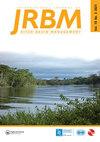Effects of morphometric characteristics on flood in Degirmendere sub-watersheds, Northeastern Turkey
IF 1.9
Q3 WATER RESOURCES
International Journal of River Basin Management
Pub Date : 2021-09-23
DOI:10.1080/15715124.2021.1981355
引用次数: 3
Abstract
ABSTRACT Watershed morphometry refers to the connections between systems of a watershed, such as hydrology, geology, vegetation, and topographic structure. The topographic and hydrological characteristics of the watershed have a great impact on vegetation, retention of rainwater in the soil, and its transformation into runoff, flood, and landslide occurring in the watershed. In this study, watershed morphometric analysis of the Altindere, Zigana and Catak subwatersheds located upstream of the Degirmendere watershed in Turkey was conducted, and the potential of producing floods related to these features was investigated. As the study area, Trabzon Degirmendere subwatersheds were chosen due to flood and landslide events that have occurred in the past and caused loss of life and property damage. By considering the linear, areal, and relief morphometric properties of each subwatershed, their flood effect levels and potentials are revealed. ArcGIS software was used in the analysis. Digital Elevation Model (DEM) with a resolution of 10 m produced from 1:25,000 scale topographic maps was used as a base for the evaluation of these parameters. As a result of this study, when evaluated in terms of the morphometric properties of the watersheds, it was determined that the Zigana subwatershed has the greatest impact on flood production. This study is intended to guide decision-makers to anticipate floods and flood events that will occur in the watersheds in the future.形态计量特征对土耳其东北部Degirmendere次流域洪水的影响
流域形态计量学是指流域水文、地质、植被和地形结构等系统之间的联系。流域的地形和水文特征对流域的植被、雨水在土壤中的滞留、转化为径流、洪水和滑坡等有很大的影响。本研究对位于土耳其Degirmendere流域上游的Altindere、Zigana和Catak流域进行了流域形态计量学分析,并研究了与这些特征相关的洪水发生潜力。选择Trabzon Degirmendere流域作为研究区域,是因为过去曾发生过洪水和滑坡事件,造成了生命财产损失。通过考虑各小流域的线性、面积和地形形态特征,揭示其洪水效应水平和潜力。分析采用ArcGIS软件。利用1:25 000比例尺地形图生成的分辨率为10 m的数字高程模型(DEM)作为评估这些参数的基础。根据本研究的结果,在对流域的形态特征进行评估时,确定了Zigana子流域对洪水产生的影响最大。本研究旨在指导决策者预测未来流域将发生的洪水和洪水事件。
本文章由计算机程序翻译,如有差异,请以英文原文为准。
求助全文
约1分钟内获得全文
求助全文
来源期刊

International Journal of River Basin Management
WATER RESOURCES-
CiteScore
6.00
自引率
4.00%
发文量
48
期刊介绍:
include, but are not limited to new developments or applications in the following areas: AREAS OF INTEREST - integrated water resources management - watershed land use planning and management - spatial planning and management of floodplains - flood forecasting and flood risk management - drought forecasting and drought management - floodplain, river and estuarine restoration - climate change impact prediction and planning of remedial measures - management of mountain rivers - water quality management including non point source pollution - operation strategies for engineered river systems - maintenance strategies for river systems and for structures - project-affected-people and stakeholder participation - conservation of natural and cultural heritage
 求助内容:
求助内容: 应助结果提醒方式:
应助结果提醒方式:


